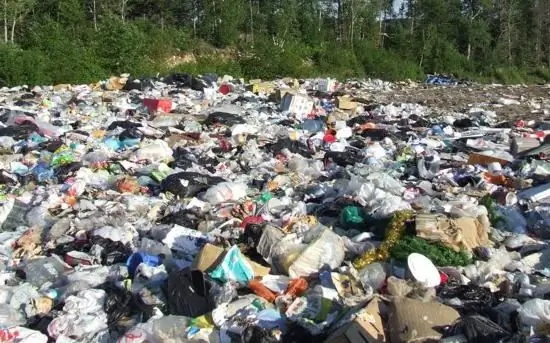2026 Author: Howard Calhoun | [email protected]. Last modified: 2025-01-24 13:10:43
The existence of biological waste is inextricably linked with the presence of organic life. For millions of years, the planet independently regulated their disposal and built them into the global ecosystem. Today, the issue of collection and disposal of biological waste is relevant for the reason that nature is no longer able to cope with the amount that a person generates every day.
Term Definition
There are several interpretations of this concept. For example, you can use the one that is given in the official documentation of Russia, in GOST 30722-2001 called “Resource saving. Waste management. Terms and Definitions . This document clearly explains the essence of the concept.
According to official data, biological waste is tissues and organs, the formation of which occurred due to the use of operational practices in medicine or veterinary medicine, as a result of biomedicalexperiments, as well as the death of animals, birds and livestock; also included are other wastes that have been obtained from the processing of food and non-food raw materials of animal origin or waste from production processes in the biotechnology industry.

Classification by groups
There are various sorting and separation options. However, in the classic version, biological waste is something related to one of the following groups:
- Confiscated from the field of veterinary medicine. Includes fish, meat or other animal products. Identified during special veterinary and sanitary examinations carried out at various slaughterhouses and slaughterhouses, markets and meat processing companies, trade organizations or other similar facilities.
- Stillborn and aborted fetuses, corpses of dead and wild birds and animals, which appeared both as a result of the natural course of events, and due to any laboratory research.
- Biological waste generated at the sites of operation and maintenance of poultry farms, industrial meat processing facilities, as well as fish farms.
- Processing of food or non-food raw materials of animal origin. Often results in a certain amount of bio-waste.

Hazard classes
When it comes to recycling, the decision is madeaccording to which particular group the object in question officially belongs to. Disposal of biological waste (the rules are given in the article) of the first hazard class, which includes stillborn or fallen laboratory and domestic animals, is carried out in one of three available ways. These include cremation of the remains, decontamination or burial in the ground.
With the second class of danger, which includes various parts of the body, any physiological secretions of people and animals with viral diseases and residues from infectious wards, it is much easier and more efficient. Such waste is usually recycled and then used in some area.
ABV-classification
The above grouping is not as common as the one described above, however, it has the right to review. In this case, the classification of biological waste is their sorting by potential danger to others and nature. The list follows.
- Class A. Potentially radioactive hazardous waste.
- Class B. Potential toxicological hazardous waste.
- Class B. Waste likely to be epidemiologically hazardous.
The last two classes have a common theme. They may include such biological waste that can be contaminated with potentially dangerous viruses such as SARS or anthrax. If they are not disposed of in a timely and qualified manner, then there are risks of the spread of yet another deadly epidemics. The authorities warn that any owner in case ofthe presence of such remains on its territory is obliged to call the veterinary supervision within 24 hours and ask for help. Specialists will take care of waste disposal. Otherwise, such an owner may incur administrative liability.

Self-disposal
Veterinary and sanitary institutions have written a list of rules by which employees perform the procedure. Cremation or burial of biological waste is strongly discouraged. However, practice shows that many private farmers completely disregard these regulations and regularly bury birds and animals in the ground, which absolutely does not meet the existing sanitary standards in the country. This problem is more relevant in those regions of the Russian Federation where animal husbandry is one of the leading areas of small business. Such actions by farmers do not lead to immediate complications, but to those that may appear much later, in the future.
Also, do not forget that biological waste is a product that can be recycled, for example, for livestock feed. This option is based on two modern technologies - extrusion and biotechnological conversion. The first allows you to process any material by water, thermal or mechanical means in order to obtain bone meal, dry food for animals and birds. Conversion splits waste into ethanol, hydrocarbons and biogas.

Incineration in crematoria
Very popular and easy way. Employees of veterinary and sanitary institutions collect preliminary waste on call, and then take it to specialized crematoria. The combustion temperature in the chamber is about 800 degrees Celsius. This value is quite enough to kill all harmful microorganisms, carriers and pathogens. The remains themselves are almost completely burned to a state of sterile ash or a fragile pile of ground bones.
As a result, such remains can be disposed of in any way. The fact is that the ashes will not attract the attention of any rodents or insects in the future. Incineration in a crematorium is considered the best option for burying a deceased pet. In the future, the owners will be able to receive an urn with ashes, which they will dispose of at their discretion.

Cattle burial grounds
Now an irrelevant way of burying animal remains. Widespread use was in the days of the Soviet Union. The option has become widespread due to the presence of huge unoccupied territories. With the collapse of the USSR, animal burial grounds were officially banned by law. This happened due to the fact that the rules for the collection of biological waste and their disposal in compliance with sanitary standards no longer allowed animals to be buried in the ground.
Earlier, there were certain areas with pits on the territory of the country, which were located on hills. At the same time, the level of groundwater occurrence is nothad to exceed 2.5 meters, and in the district it was required that there were no settlements, forests, pastures and cattle drives, wells and reservoirs at a distance of at least 500 meters. Now in such areas you can find special signs with descriptions and warnings.

Collection and Disposal Policy
For different categories there is a list of restrictions and regulations. For example, SanPiN prescribes mandatory transportation in special closed tanks or containers for food biological waste. Collection and removal is prohibited in ordinary garbage bags. In urban environments, responsible authorities empty, clean and disinfect waste disposal sites on a daily basis.
The law also states that individuals are prohibited from using any professional equipment whose purpose is to carry out recycling. The same SanPiN prescribe that storage of biological waste is allowed at special sites, while the height of the sides of the tanks should not exceed 12 centimeters. The latter act as restrictors that prevent liquids and residues from draining and falling out, respectively.

Ways of the Future
Scientists are developing a special method for the destruction of biological waste, called "bioremediation". The bottom line is that various microorganisms utilize and neutralize the products of biologicalorigin. The advantages of this approach are obvious: no harm to nature, targeted application, high safety, efficiency and controllability. Introduced microorganisms multiply in dead organic matter, and then completely assimilate and process it into carbon dioxide, water and humus.
Recommended:
Waste disposal - what is it?

The legislation establishes the obligatory receipt of a license for waste disposal. This permit is issued for specific types of waste raw materials. The license, which was received before 07/01/2015, is valid until 01/01/2019
Wood waste: main sources of formation and types of disposal

Humanity is seriously faced with the problem of waste disposal, so all over the world are developing more and more advanced methods of waste disposal. Recycling is now such a fashionable foreign word. In developed countries, resource conservation is an important motivation for wood recycling. How is it in our country?
Low-waste and waste-free technologies: definition, description, problems and principles

Problems of the harmful effects of industry on the environment have been worrying environmentalists for a long time. Along with modern means of organizing effective methods for the disposal of hazardous waste, options are being developed to minimize the initial damage to the environment
Classification of production and consumption waste. Classification of waste by hazard class

There is no general classification of consumption and production waste. Therefore, for convenience, the basic principles of such a separation are often used, which will be discussed in this article
Class B waste: storage and disposal

In the course of the activities of medical institutions and other institutions of a similar nature, a huge amount of waste, used materials and substances appear. They carry a potential hazard to human he alth in case of possible contact, so the issue of disposal and disposal is quite acute

